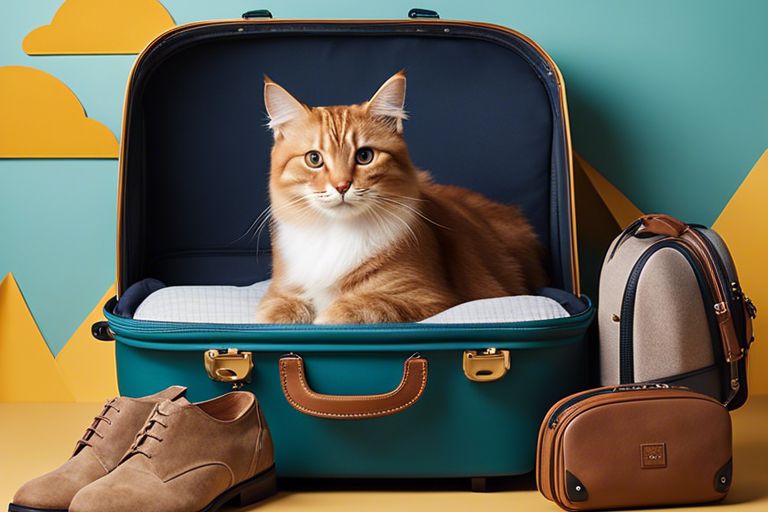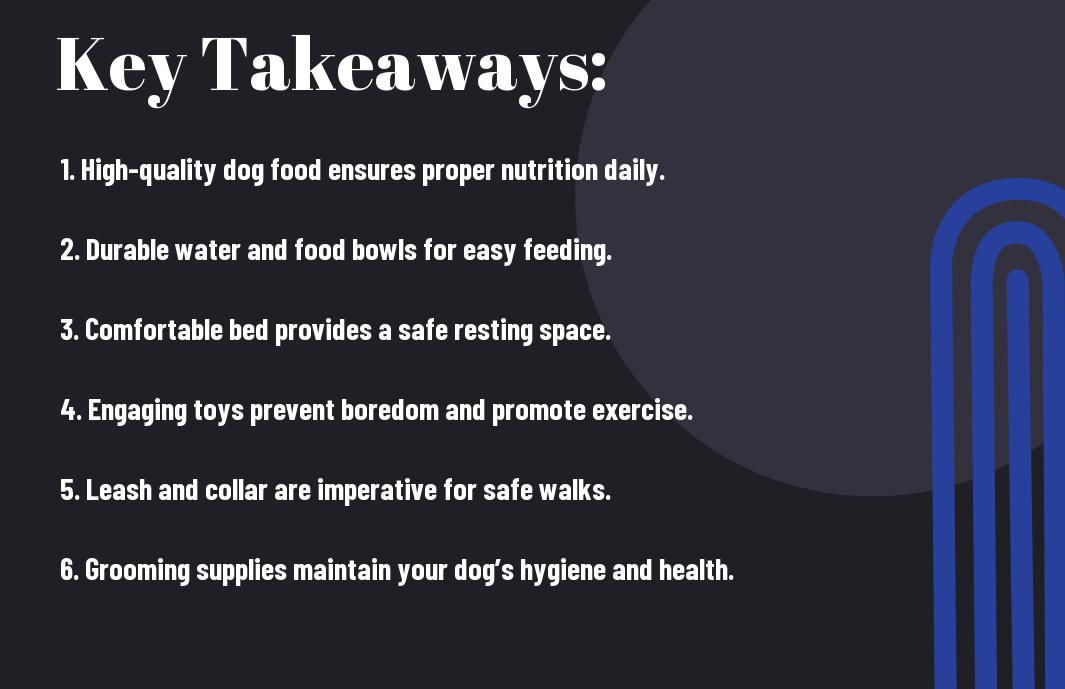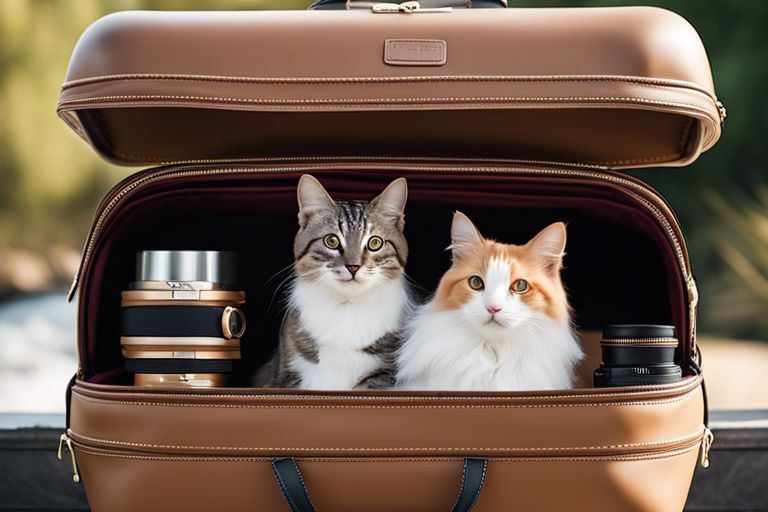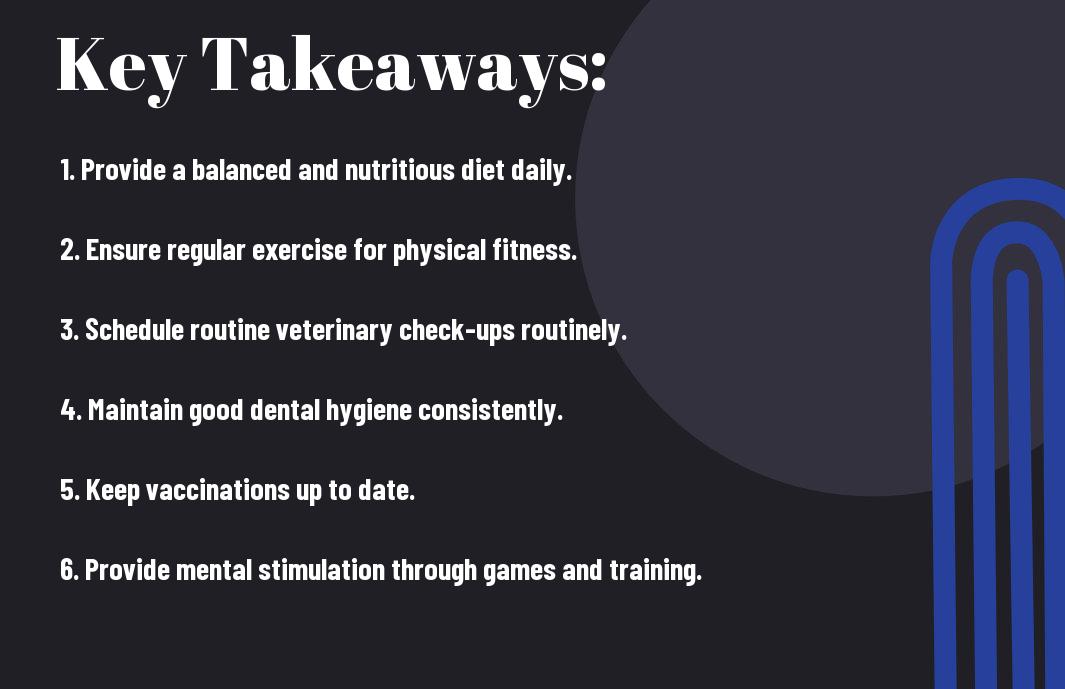Many dog owners are eager to include their furry friends in travel plans, yet without proper preparation, the journey can turn stressful for both you and your pet. Being aware of travel regulations, scheduling adequate breaks, and ensuring your dog’s comfort and safety are vital for a smooth trip. This blog post will provide you with imperative tips to make traveling with your dog not just feasible, but enjoyable. So pack your bags and leash, and get ready to hit the road with your four-legged companion!
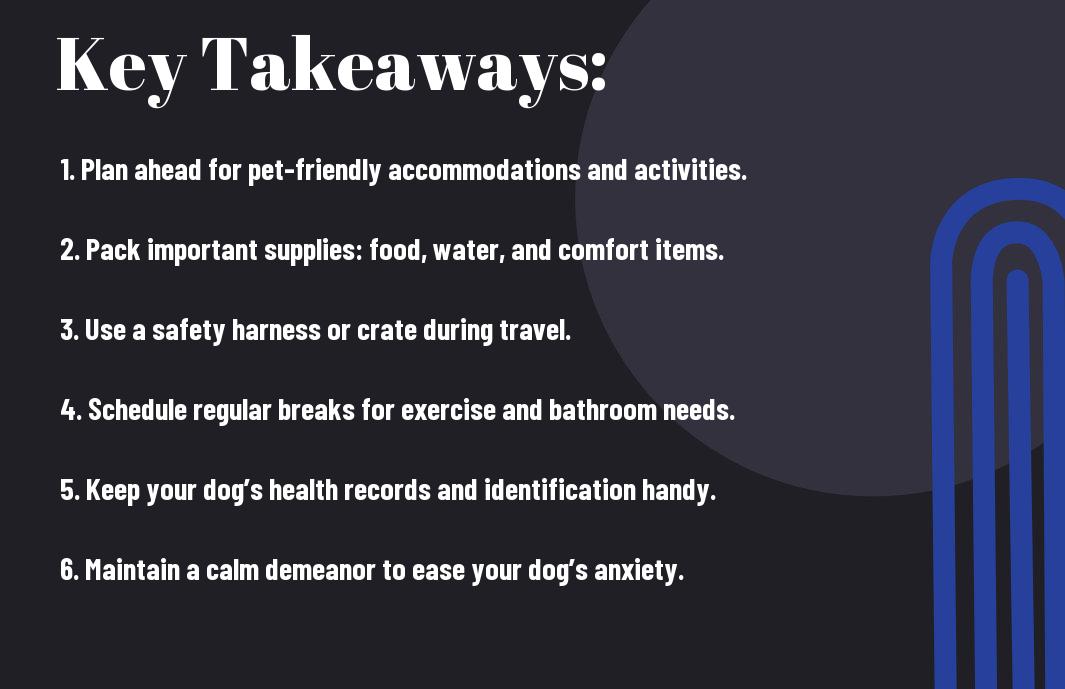

Preparing for Your Trip
Assessing Your Dog’s Readiness
About to commence on an adventure with your dog? Start by assessing whether your furry friend is ready for travel. Consider factors such as their age, temperament, and previous travel experiences. If your dog is generally calm and enjoys new environments, they’re likely suited for a journey. Conversely, if your dog is anxious or struggles with unfamiliar situations, it may be worth evaluating if the trip would be stress-inducing for them.
You should also assess their physical condition. Dogs that suffer from chronic illnesses or have mobility issues may require special attention while traveling. Take note of your dog’s behavior in various settings. If they react positively to short car rides or visits to new places, it bodes well for your upcoming trip. However, if they show signs of discomfort, it might be best to consult your vet before making any plans.
Health Check and Vaccinations
For a safe and hassle-free journey, it is advisable to conduct a thorough health check of your dog. Schedule a visit to your veterinarian to ensure they are in good health and up-to-date on vaccinations, especially if you’re traveling to a new region or country. Some places have specific vaccination requirements, and being equipped with their vaccination records can facilitate smoother entry into pet-friendly accommodations and public areas.
Additionally, inform your vet about your travel plans so that they can offer any specific advice or recommendations pertaining to your dog’s breed and health history. This is also a good time to discuss administering flea and tick prevention treatments, as you’ll want to protect your furry companion from any parasites they might encounter while exploring new environments.
It’s necessary to always carry your dog’s medical records, including vaccination history and any medications they might need during the trip. This way, you are prepared in case of emergencies or if you need to consult with a new veterinarian.
Packing Essentials for Your Dog
Along with your own travel necessarys, ensuring you pack everything your dog needs is vital for a comfortable journey. Start with their food and water dishes, a supply of their regular food, and bottled water, especially during long trips. Familiar items such as their favorite blanket or toys can provide a sense of security and help them feel at ease in new surroundings.
Don’t forget to include a sturdy leash, waste bags for clean-up, and a first aid kit containing important items like bandages, antiseptics, and any medications your dog might need. Preparing a designated space for your dog’s belongings will help streamline the packing process and ensure you have all necessarys within easy reach.
Health and comfort items, such as a travel crate or car seat, should also be packed to ensure your dog’s safety during transit. These items not only protect your dog but also provide a familiar environment, making them feel more secure while traveling.
Choosing Pet-Friendly Accommodations
Around your travel plans, the choice of where to stay should prioritize pet-friendliness. Research accommodations that openly welcome dogs, as not all hotels or rental properties allow pets. Look for establishments that specify their pet policies, including size restrictions and any additional pet fees that may apply. Many hotels offer amenities specifically for pets, allowing for a smoother experience for both you and your dog.
When making reservations, don’t hesitate to call the hotel directly to clarify their rules regarding pets, as well as any additional services they might offer, such as dog walking or pet-sitting services. This will ensure that you’re fully aware of what to expect and can plan accordingly. Being well-informed about your accommodation options can enhance your overall travel experience.
For instance, some properties have designated dog parks or nearby walks, which can make your stay even more enjoyable. Ensuring your accommodation caters to your dog’s needs can help alleviate travel stress and enhance the bond you share during your trip.

Transportation Options
Clearly, choosing the right transportation option is vital for ensuring your travel with your dog is as smooth and enjoyable as possible. Your choice will depend on several factors, including your destination, the length of your trip, and your dog’s temperament. Whether you opt for car travel, flying, or other forms of travel, there are specific considerations you should keep in mind to create a stress-free experience for both you and your furry friend.
Traveling by Car
After preparing your dog for the journey, car travel presents you with a flexible option that many dog owners prefer. Ensure your pet is secure in a carrier or with a dog seatbelt to prevent distractions while driving. It’s important to plan for frequent stops to allow your dog to stretch, relieve themselves, and hydrate. This will help keep your dog calm and comfy throughout the trip, which can significantly reduce anxiety.
Additionally, make sure to pack a travel kit that includes their favorite blanket, toys, and plenty of snacks. A familiar scent can help soothe your dog during the ride, turning the car into a more secure and welcoming environment. Avoid leaving your dog in a parked car, as even mild temperatures can lead to overheating and distress. With thorough preparation, your car journey can become a positive bonding experience.
Traveling by Plane
Beside driving, flying is another transportation option to consider when traveling with your dog. However, flying can introduce its own set of challenges. Some air travel regulations require you to book your dog a space in the cargo hold, while others permit small dogs to travel in the cabin with you. Always check with the airline beforehand to ensure you comply with their specific pet policies. Arriving at the airport well in advance will allow you enough time for check-in and security procedures, reducing the chances of last-minute stress.
Moreover, it’s vital to prepare your dog for the flight by getting them used to their travel crate in advance. This familiarization can help alleviate anxiety and make the transition smoother while airborne. Always pack vitals such as your dog’s health records, water, and any medications they may need, which will assist in keeping your pet calm and comfortable throughout the journey.
Hence, when flying with your dog, you should also consider investing in a high-quality crate that meets the airline’s specifications. This will ensure the safety of your pet during travel and provide you with peace of mind. Additionally, ensuring your dog is well-exercised before flying can help mitigate potential hyperactivity or anxiety during the flight.
Other Forms of Transportation
Security can be a concern when it comes to using other forms of transportation, such as trains or buses. Depending on where you’re traveling, policies regarding pets can greatly vary. Some train services may allow dogs, while others might not. Always verify the logistics and any restrictions when planning your trip. On buses, small dogs may be permitted as long as they are in a carrier. Always ensure that your furry friend is well-behaved to avoid conflicts with other passengers.
Additionally, consider the duration of your journey since long travel times can be particularly challenging for dogs. Preparing appropriately with water, food, and comfort items is vital. Transporting larger dogs may be more complex, so be proactive in determining the best travel option that accommodates both you and your pet.
Another factor to keep in mind is how other transportation options may have fixed schedules, potentially leading to longer travel times and transit waits. Researching booking policies ahead of time will enable you to secure the best spots and help create a smoother journey for your pup.
Before You Leave
For any pet parent, preparing for a trip with your furry friend goes beyond simply packing your bags. It’s crucial to lay the groundwork for a smooth journey, ensuring that your dog feels secure and comfortable. The more prepared you are, the more likely you are to have an enjoyable experience for both you and your pup. Start by considering your dog’s temperament and needs, which can make all the difference in how they handle the travel environment.
Keeping Your Dog Calm
Among the most effective ways to keep your dog calm during your travels is to create a relaxed atmosphere. Before you hit the road, set aside some quiet time where you can help your dog acclimate to the upcoming changes. Play soothing music or engage in gentle petting sessions to promote a sense of tranquility. Using familiar toys and bedding during your trip can also provide comfort, making your dog feel at home even when not in familiar surroundings.
Another helpful technique is to maintain a consistent routine leading up to your departure. This consistency may include regular meal times, play sessions, and walks, which can prevent any added anxiety. If your dog tends to get nervous, consider consulting your vet about calming products or supplements that you can administer before your trip. These measures can significantly reduce stress for both you and your dog.
Familiarizing Your Dog with Travel Gear
Before you venture out on your trip, it’s imperative to introduce your dog to the travel gear you’ll be using. Taking the time to do this will allow your pet to associate these new items—such as harnesses, crates, and car barriers—with positive experiences. Begin this process a few weeks before your trip by incorporating the gear into daily routines, such as having your dog wear the harness during short walks or allowing them to explore a crate in a stress-free environment.
Gear familiarity not only makes your dog more comfortable, but it also enhances their safety during travel. By understanding and accepting these new items, your dog will likely feel secure while in transit, reducing behavioral issues that can arise from stress or confusion.
Updating Identification and Microchip Information
Before you initiate on your adventure, ensure that your dog’s identification and microchip information are current. This includes verifying that tags contain your most recent contact information and ensuring your microchip is registered with accurate details. In the event your dog becomes lost, having updated identification provides the best chance of quickly reuniting you with your pet, reducing potential heartache during your trip.
Also, if you’re traveling to another state or country, familiarize yourself with the local regulations and requirements regarding pet identification. Some places have specific rules that could involve additional documentation or evidence of vaccinations, which is crucial to address beforehand to avoid complications during your travels.
During the Trip
Once again, taking your dog on a trip can be a rewarding experience, but it also comes with its own set of challenges. You want to ensure that your furry friend feels comfortable and safe during your travels, as well as looking out for their health and well-being. By addressing their needs proactively, you can create a positive environment that enhances the experience for both of you.
Managing Anxiety and Stress
Any change in routine can trigger anxiety in dogs, and traveling is no exception. To help your dog cope with stress, you can bring along familiar items from home, such as their favorite blanket or toys. Giving your dog plenty of time to acclimatize to new surroundings is also beneficial. Consider scheduling breaks during your journey for walks and potty breaks to allow your dog to stretch, explore, and relieve themselves—this also helps to break up the monotony of travel.
Additionally, using calmative aids such as pressure vests or calming treats can help reduce anxiety during your trip. If your dog is particularly nervous, consult with your veterinarian ahead of time for recommendations that may include pheromone diffusers or medications to help ease their anxiety.
Maintaining Your Dog’s Routine
Maintaining your dog’s routine is vital during travel, as it helps ground them in an otherwise unpredictable environment. Try to keep meal times consistent, and schedule regular potty breaks. By following a familiar pattern of activities, your dog is likely to feel more at ease and less agitated by the changes that traveling brings.
Routine establishes a sense of security and can help curb unwanted behaviors brought on by stress, so make an effort to stick to the usual feeding, walking, and playtime schedules as closely as possible. This attention to routine will create a more enjoyable experience both for you and your dog.
Staying Hydrated and Fed
Hydrated and well-fed dogs are happier travelers. Make sure to bring enough food and water, along with collapsible bowls for easy access. During stops, offer your dog water to ensure they stay hydrated, especially if you’re traveling to warmer climates. Hydration can significantly impact their mood and energy levels, so always keep this a priority.
But be cautious about sudden changes in diet while on the road. Introducing new foods too quickly can lead to digestive upset, so try to stick to your dog’s regular diet as much as possible. If a food switch is necessary, do so gradually to minimize any potential issues.
Emergency Preparedness
Against all odds, incidents can happen while you’re on the road. Ensure you are prepared for emergencies by keeping an updated first-aid kit specific for your dog. Include crucial items like bandages, antiseptic wipes, and any medications your dog may need. Knowing how to administer basic first aid may come in handy should an issue arise during your trip.
In addition, having identification for your dog is vital. Make sure your dog is chipped, and consider getting a temporary tag with your travel contact information. This way, if your dog gets lost during your travels, whoever finds them can quickly reunite you. Being prepared can drastically reduce the stress of unforeseen circumstances, letting you focus on making great memories together.
Activities and Exploration
All dogs thrive on exploration and activities, especially when traveling with their humans. Creating a mix of exciting adventures and downtime is necessary for a stress-free experience. A well-planned itinerary will enhance your trip, allowing your dog to enjoy new sights and sounds while keeping their routine in mind.
Pet-Friendly Destinations
Before you begin on your journey, research pet-friendly destinations that cater to dogs. Many cities now offer parks, beaches, and amenities that welcome pets. You won’t want to miss out on places known for their dog-friendly attractions, such as national parks that allow dogs on trails or towns with dog parks and outdoor cafes. By selecting these destinations, you can ensure your furry friend can enjoy the trip just as much as you do.
Additionally, look for accommodations that accommodate pets, whether it’s a hotel, rental, or campsite. Some places offer special services for pets, including pet-sitting, dog spas, or even dog parks onsite. Researching pet-friendly options will enhance your experience and give you peace of mind knowing that your dog will be welcome.
Outdoor Activities with Your Dog
At your chosen destination, outdoor activities are a fantastic way to bond with your dog while exploring new terrains. For instance, consider hiking, nature walks, or even visiting dog-friendly beaches. Ensure you have the right gear, including comfortable leashes, collapsible water bowls, and dog-friendly snacks to keep your pup hydrated and energized.
Your dog will appreciate the opportunity to run, explore, and experience nature during your travels. Engaging in these activities can help expend their energy, ensuring they remain calm and relaxed throughout your trip. Always keep an eye on your dog during outdoor adventures, particularly in unfamiliar areas, to ensure they stay safe and don’t venture off without you.
Dining Out with Your Pet
Before venturing out to eat, explore local restaurants that have outdoor seating or specific accommodations for dogs. Many eateries now provide special menus for pets or even invite you to bring your furry friend inside. Checking online reviews and pet-friendly guidelines will help you narrow down your choices to those that ensure both you and your dog are comfortable.
Furthermore, be aware of the dining environment; noisy or overly crowded settings may stress your dog. Opt for places with a calm atmosphere where you both can enjoy a meal. Your dog will appreciate being included in your dining experience, elevating your trip even more.
Plus, don’t forget to bring your dog’s favorite blanket or bed to help them feel at ease in a new setting while dining. Treating your pet to a special meal or snack can also enhance their experience, turning dining out into a delightful event for both of you.
Post-Trip Care
After your trip, it’s crucial to ensure that both you and your dog transition back to normal life smoothly. While traveling can be a fun experience, it may also take a toll on your furry companion. To help your dog recover and maintain their health, focus on a few key practices.
Health Check After Traveling
Before resuming your regular activities, conduct a health check on your dog. Look for any signs of discomfort or illness such as coughing, lethargy, or changes in appetite. If your dog has been around other animals during your travels, a quick visit to the vet for a checkup and any necessary vaccinations could be beneficial. Pay attention to their skin for any signs of irritation or pests that they may have picked up. Observing your dog closely during this time can help you catch potential issues early.
After ensuring your dog’s immediate health is stable, you may want to monitor their behavior closely for a few days. Stress or anxiety from travel could manifest in changes in behavior, so keep an eye out for anything unusual, including excessive barking, hiding, or reluctance to eat. If anything seems out of the ordinary, consult your veterinarian for advice on how to help your dog adjust back home.
Re-establishing Routine at Home
Health and comfort are key when it comes to re-establishing a routine for both you and your dog. Try to return to your regular feeding and walking times as quickly as possible after your trip. Dogs thrive on routine, which helps them feel secure and grounded. Make sure to maintain the same practices that provided them stability before your travels, such as regular playtime and training sessions. This familiarity will aid in easing any anxiety they might feel from being in a new environment.
Traveling can disrupt your dog’s usual rhythm, but by re-establishing a predictable schedule, you will be providing them with a sense of normalcy. Incorporating familiar toys, engaging in favorite activities, and sticking to the same bedtime routine can significantly benefit their emotional and physical well-being.
Assessing Your Dog’s Travel Experience
Traveling with your dog often presents both positive and negative experiences, and it is important to assess how your dog fared during your trip. After your journey, take some time to reflect on what your dog seemed to enjoy and what they found stressful. Pay attention to their mood and energy levels during travel and after returning home. This evaluation will help you make informed decisions for future trips, ensuring that both you and your dog can enjoy a more comfortable experience together.
By objectively assessing your dog’s experience, you can identify situations they might tolerate better next time and those that should be avoided. Whether it is a change in traveling method, types of accommodations, or duration of travel, these insights are vital for planning future adventures that will enhance your bond.
Home is where your dog feels safest, so prioritizing their well-being after returning from a trip is necessary. Taking care of your dog’s health, reinstating their routine, and evaluating their travel experience will help them readjust and thrive in their familiar environment.
Final Words
Following this guide will help you ensure a smooth and enjoyable travel experience with your dog. As you prepare for your trip, consider your dog’s individual needs, from comfort to health and happiness. Plan ahead by choosing pet-friendly accommodations, packing necessary supplies, and keeping your dog’s safety in mind during travel. By addressing these key factors, you can reduce stress for both yourself and your furry companion, allowing you to focus on creating memorable moments together.
Traveling with your dog can be incredibly rewarding and can deepen the bond you share. By taking the time to prepare accordingly and staying alert to your dog’s comfort and behavior during the journey, you enhance the likelihood of a smooth trip. As you launch on your adventures, embrace the flexibility that comes with traveling with a pet and enjoy exploring new destinations together.
Q: What preparations should I make before traveling with my dog?
A: Before commenceing on your journey, it’s important to prepare both yourself and your dog to ensure a pleasant experience. Start by visiting your veterinarian for a check-up and to discuss any vaccinations or medications that might be necessary. Additionally, gather any needed supplies, such as a comfortable travel crate or harness, food, water, leash, and waste bags. Familiarize your dog with the crate or carrier ahead of time, allowing them to feel comfortable and secure. Lastly, plan your route with dog-friendly stops and accommodations to ease the journey.
Q: How can I keep my dog calm during travel?
A: Keeping your dog calm during travel can be achieved through several tactics. First, establish a routine that includes playtime and exercise before the trip to help them burn off excess energy. During travel, positive reinforcement techniques, including treats and praise, can help reassure your dog and reduce anxiety. Additionally, consider using calming aids such as pheromone sprays or anxiety wraps, which can create a soothing environment. Frequent breaks for bathroom visits, stretching, and hydration will also contribute to your dog’s well-being and relieve stress.
Q: What should I do if my dog gets car sick or anxious while traveling?
A: If your dog experiences motion sickness or anxiety in the car, there are several strategies to help. First, ensure your dog is safely secured in a crate or with a seatbelt harness to prevent movement and potential injuries. To reduce car sickness, try feeding your dog a light meal a few hours before departure, and keep the car well-ventilated. Gradual desensitization to car rides can also be effective; take short trips leading up to your longer journey. If your dog’s discomfort persists, consult your veterinarian about potential remedies, including medication to help alleviate anxiety or nausea during travel.
